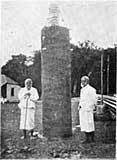|
Upper Navua River (p.97) With a river-going outrigger canoe - velovelo or takia (see picture & notes below, ref. p.165). Though the term takia is today often applied to all Fijian outriggers, this is incorrect. Takia are calm-water craft, either poled or sailed. As can be seen, the main hull is a simple dugout, and would quickly swamp at sea. A sailing outrigger, by contrast, has a deck (tau) over the hull, and is thus called a waqa vakatau, of two main forms, camakau ("wooden outrigger float") [see photo and drawing] and tabilai, a larger outrigger halfway to the twin-hulled drua(pictured below, ref. p.141). |
|
| Fijian meke club dance [mekewau] (p.137). | |
|
Chief's house and sleeping bure (p.141) [Bau Island]. In fact the small attached building would not be called a bure but a valemoce. In the foreground a quite large ocean-going outrigger canoe (camakau). |
|
|
Canoes [takia] on the Tamavua River (p.165). Thomas Williams wrote: "the takia is open throughout its length like a boat, and the spars to which the cama is secured rest on the gunwale" (p.72). These features are clearly visible here. |
|
|
"Contribution of Natives to Governor at the time of the Coronation of the King" [George V] (p.6). [See note for next picture] |
|
|
"Roll of Magi Magi (sinnet or cocoanut fibre rope) presented by natives to Governor on Coronation of King [George V]. (This roll contains upwards of seven miles of rope in one length)." (p.7) This was more probably a gift at the post-funerary rituals related to the death of King Edward VII. This inference may be drawn from the fact that the tall roll of 2-coloured sinnet (magimagi) with a smaller roll of barkcloth (masi) in the top end of it, the whole symbolising a human figure, is a lawa ni mate, used only in Lau as a presentation object, generally at funerary rituals of the highest note. |
|
|
"Solomon Islanders' Canoe in Suva harbour." (p.67) There is no explanation for the presence of this canoe or its crew in Suva Harbour. While there were many Solomon Islanders in Fiji as indentured labourers (and their descendants are still there), it would seem improbable that expatriates would have fashioned so detailed and ornate a vessel. Perhaps it was in Suva as part of a cultural event of some sort. A postcard of the same decade depicts a similar, though less ornate, vessel in Fiji with paddlers wearing unmistakeably Solomon Islands gear. |






